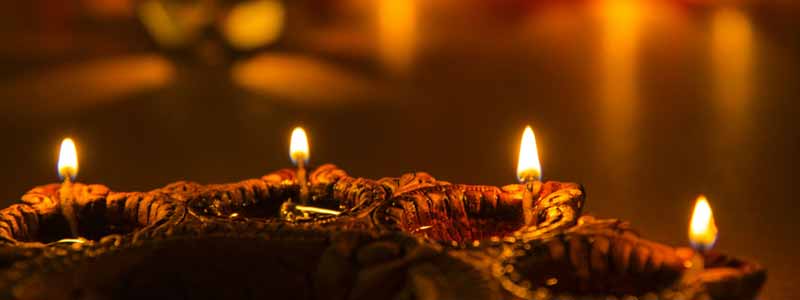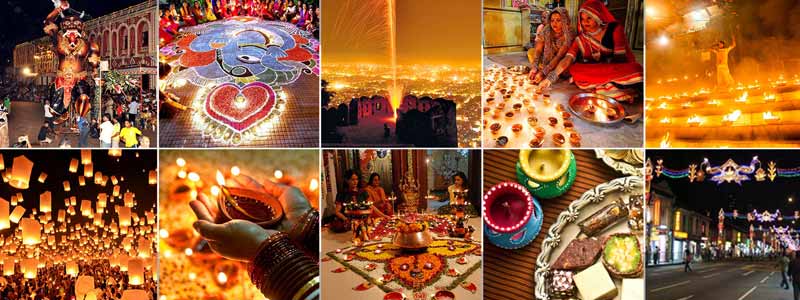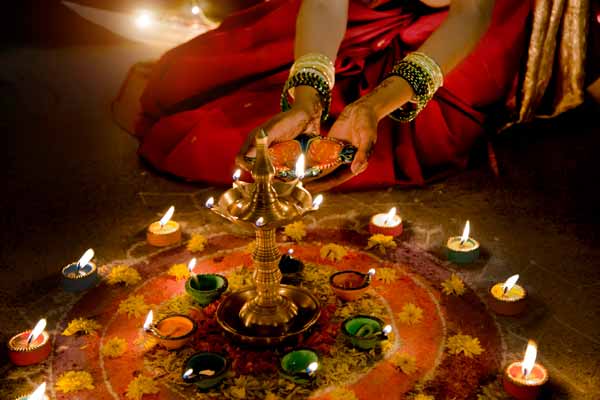Diwali Celebrations in Rajasthan, also known as ‘Deepawali‘ is celebrated with whole enthusiasm and devotion in Rajasthan like every part of India. Known as ‘The Festival of Lights’, Diwali is almost celebrated by all religions in Rajasthan. Diwali is celebrated for many reasons. Some celebrate Diwali as it is believed that it marks the starting of the Hindu New Year according to the Lunar calendar. But most people celebrated it as the victory of Goodness over Evil.
The enthusiasm with which people celebrate this festival in Rajasthan elaborates on their zest, passion and importance of this festival. Even a small town of Rajasthan celebrates this festival with tremendous gusto, but the cities of Jodhpur, Udaipur and Jaipur give a whole new meaning to the words festivals and celebrations during Diwali Celebrations in Rajasthan.

History of Diwali : How Diwali Started
According to the Hindu epic ‘Ramayana’, Diwali was celebrated for the first time when Lord Ram returned to his home ‘Ayodhya’ after killing Ravan.
It is believed that when returned to Ayodhya along with Laxman, Sita, and Hanuman, people of Ayodhya lit up oil lamps in their homes and turned the dark night into a light festival.
From that day, every year Diwali or Deepawali (Deep mean oil lamps) is celebrated to mark the victory of goodness over evil Diwali Celebrations in Rajasthan.

When is Diwali?
The Festival of Lights is known as Deepavali (deep – lamp, vali – array). This is the name of the festival in Southern India and is how the festival is referred to in other Asian countries such as Malaysia and Singapore. In Northern India, it is more commonly known as Diwali Celebrations in Rajasthan, but they are essentially the same celebration.
In these countries and for Hindus around the world, the celebration revolves around the triumph of good over evil, purity over impurity, light over darkness. It is one of the most important Hindu festivals.
The Five Days of Diwali
Diwali is a five-day festival that straddles the new moon. Though widely celebrated across all of India, the days may have different names and have additional meanings in some parts of India, there is enough commonality to briefly describe each of the days:
1. Dhanteras
Dhanteras marks the beginning of the five-day festivities of Diwali. On this day, it is customary for people to clean their houses, so they are ready to welcome in Lakshmi, the Goddess of Wealth and Prosperity, whose Puja is performed in the evening. This is an auspicious day and a lucky day for buying expensive goods, though it is also a day to consider charity for those less well off. Diwali Celebrations in Rajasthan Small clay lamps, called diyas are lit to drive away the shadows of evil spirits.
2. Naraka Chaturdashi
According to Hindu tradition, the demon Narakasura was killed by Lord Krishna on the second day. Marking the coming end of the year in some regions of India, customs on this day are about cleaning the slate before the start of a new year and getting rid of anything bad. People get up early and wash and put on clean or new clothes. In parts of Southern India, this day is celebrated as the main day of Diwali Celebrations in Rajasthan.
3. Diwali
The third day is celebrated on the new moon in Kartik. In most parts of India, this is the most important day of the festival and is the last day of the year in many regions of India. On this day, Lord Rama rescued his wife, Sita, from the demon Ravana and returned home after a long exile. Diwali Celebrations in Rajasthan Candles are lit to celebrate his victory and to light his way home after the battle. In the evening, it may seem like the whole of India is lit by explosions as people set off many fireworks.
4. Balipadyami
The fourth day of Diwali is also the first day of the new year in the Vikram Samvat calendar and may also be known as Pratipada, Govardhan Puja or Annakut. Annakut means ‘mountain of food’, which is a giveaway that today is all about feasting. Tradition has it that on this day, Lord Krishna lifted Govardhan Hill to give shelter from torrential rains to local villagers. Diwali Celebrations in Rajasthan Today, Hindus prepare a great deal of food and take it to the temples to celebrate the beginning of the new year and give thanks to Krishna for his benevolence.
5. Bhai Bij
This is the fifth and last day of Diwali festival. This day celebrates the relationship between brother and sister. Read more about Bhai Bij.
Best places to visit in Rajasthan for Diwali
Diwali is the time when you go home to your family and loved ones; when you buy gifts for each other, light diyas and phuljadhis (sparklers) with the kids in the house. But in some cities and states in India, these pan-India celebrations reach the all-time-high, the grandest form, that calls for a must-visit! Below we have listed Diwali celebrations in some Indian cities where the fervor is electric and welcoming!
Jaisalmer
During Diwali, Jaisalmer becomes magical with colors and shimmers. The city shines brightly with firecrackers, lights, diyas and sweets. In the Sam Sand Dunes, people enjoy stay and have fun with music, dance, camels and sand dunes. On the evening of Diwali, a parade marching through the city can be witnessed, Diwali Celebrations in Rajasthan.
Jaipur
Jaipur looks just wow during Diwali. The way it is decorated with lights is worth watching for every tourist. The glittering bazaars are filled with lights and many offers to attract the customers. There is a Diwali Carnival which is an exhibition running for a week where several shopkeepers gather to create a perfect arena for shopaholics. After celebrating Diwali in Jaipur, you can enjoy the Rajasthan tour packages from Jaipur. You can also visit the Nahargarh Fort at the top of the hills of Jaipur to see the panoramas of gleaming Jaipur.
Pushkar
Pushkar is as usual a peaceful place even during Diwali. This city is a perfect place for those who wants to relax and stay away from noise pollution and hustle-bustle of the city life. The Pushkar Lake is a major attraction to see this time when it is illuminated with diyas. Also, the homes and streets are lighted and geared up for Diwali celebrations. All the cities are getting for Diwali at this time Pushkar gets busy in getting it prepared for upcoming Pushkar fair which is just after 15 days of Diwali Celebrations in Rajasthan.
This fair is the largest cattle fair in the world. Several competitions and contests can be enjoyed during this time. It is an ideal time to catch the glimpses of royalty and grandeur of Rajasthan and get connect with its culture and traditions by booking Rajasthan travel packages.
Udaipur
Just like other cities of Rajasthan, Udaipur is also filled with lights and diyas at every home and street. The City Palace looks beautiful and charming with the illuminating lights. In the evening, people reach at the lakes to float the diywas in the water of a lake. The views are mesmerizing when thousands of diyas float in water.
People celebrate Diwali by exchanging gifts and sweets with other families and friends. Younger ones seek blessings from their elder ones. Locals wear traditional attire on this day and adorn themselves with gold and silver ornaments. The best way to witness Diwali celebration is by staying with a local family to get a deep insight of this festival, Diwali Celebrations in Rajasthan.
